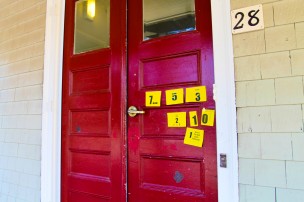
Every few days of the past ten, woodframe and program house residents have woken up to slips of neon paper tacked to their doors. The mysterious occurrences unsettled many students, leading to multiple reports to Public Safety and the Office of Residential Life (ResLife), as well as many confused tweets and posts on the Anonymous Confessions Board (ACB).
On Sunday, Sept. 29, Sustainability Interns Isabel Stern ’14 and Ari Lewenstein ’16 revealed in an email to residents that the numbers were posted as a countdown to the Do It In The Dark energy saving competition, which starts today, Tuesday, Oct. 1.
“It was very exciting to see this all build and to have chatter on campus,” Lewenstein said. “People were talking about Do It In The Dark, but they didn’t know they were talking about it.”
On Wednesday, Sept. 18, Stern, Lewenstein, and Ellen Paik ’16 met to plan this year’s Do It In The Dark competition. They decided to kick off the competition at the beginning of October, which at that point was only about two weeks away.
To publicize the event, Lewenstein suggested a countdown. He decided to post only the numbers ten, seven, five, three, two, and one. In order to post the numbers, six students woke up at 7:30 a.m. on six mornings and taped quarter sheets of paper—Lewenstein confirmed that the numbers were printed on reused paper and recycled when taken down—to their assigned houses. Stern explained that they delegated the approximately 200 woodframe and senior houses based on proximity to the volunteers’ own dorms.
“We looked at a map of the campus and where people are living and divided the 200 houses up based on that,” Stern said.
Lewenstein, Paik, and Stern added graphics, such as an ellipsis and a lightning bolt to symbolize electricity, to some of the numbers. On Sunday, the day that the trio revealed the reason behind the numbers, they posted a slip with the number two on campus doors. This particular note included a Quick Response barcode that linked the YouTube music video Zach Valenti ’12 made over the summer to advertise Do It In The Dark.
During Do It in the Dark’s fall competition, which runs through November, the Sustainability Office will track how much heat and electricity the woodframe and program-house residents consume. This year’s data from each house will be compared with the energy use of the same house during the corresponding months from the last three years. The house with the greatest percent decrease in energy usage will win the competition.
Stern explained that Do It In The Dark is a win-win program because it both saves energy and teaches students about efficient energy practices.
“For now, Wes pays for our energy,” Stern said. “But after we graduate, it’ll come out of our wallet, so we need to learn low energy lifestyles.”
While in previous years there was a single winner, this year there will be one program house winner and one woodframe house winner. The winning program house will receive $100 to buy an item for the house to share. Residents of the winning woodframe house will split a $150 gift card to Middletown restaurants and stores.
Over the course of the competition, the Sustainability Office will host many events, including a “Sweater Days” campaign to encourage students to turn the heat down and community viewings of the World Series and other major sports events.
“[We’re hoping to] keep the spark and make sure the competition doesn’t go flat,” Stern said.
For the first time in its four years of existence, Do It In The Dark will help raise money for Wes to Wes. Paik founded Wes to Wes in order to help raise money for financial aid last year when the University changed from a need-blind to need-aware admissions policy.
“I was looking for a way to lift everyone’s spirits in a productive, positive manner and realized we could focus on inefficient spending of [the] school, and see if we could redirect it into financial aid,” Paik said.
Paik explained that Wes to Wes collects money saved from decreased energy consumption from all campus residences, while the Do It In The Dark competition only measures savings from woodframe and program houses.
Sustainability Director Jennifer Kleindienst noted that Director of Utilities Management Peter Staye and Physical Plant manage all of the behind-the-scenes work for the competition, such as calculating the energy saved based on metering data. She added that 76 percent of Wesleyan’s carbon emissions comes from energy use.
According to Paik, approximately 20 percent of energy used by the University is wasted, which is equivalent to $1.6 million that can potentially be channeled into financial aid. The financial savings from energy conservation through the Do It In The Dark competition will go to this fund.
“Instead of all working separately to save energy, we’ll work together,” Paik said. “We tagged on the same project to create a campus-wide event.”
Kleindienst noted the importance of the competition.
“We need to focus on how we see energy,” she said. “The University has been doing things to make it better, but it hasn’t asked individuals to do their part. We hope that Do It In Yhe Dark and Wes to Wes will get people excited about joining in on Wesleyan’s sustainability efforts.”


Leave a Reply